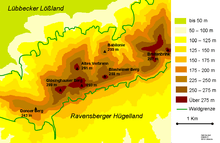Babilonie
The Babilonie is a hillfort of the La Tène culture at a height of 255.6 metres above sea level on the northern edge of a rounded hill in the Wiehen Hills above the Lübbecke village of Obermehnen in the district of Minden-Lübbecke in the German state of North Rhine-Westphalia. The name is derived from the Germanic baben in the lon i.e. "up in the woods".

| Babilonie | |
|---|---|
Babilonie archaeological heritage site Bodendenkmal Babilonie'' | |
| Obermehnen in the Wiehen | |
 Babilonie above Obermehnen | |
 Babilonie | |
| Coordinates | 52°16′36″N 8°34′36″E |
| Type | hill castle |
| Code | DE-NW |
| Height | 255 m above sea level (NHN) |
| Site information | |
| Condition | double rampart system, earthwork |
| Site history | |
| Built | 300-150 B.C. |
| Materials | Wooden posts and palisade protected by an earthwork |
| Garrison information | |
| Occupants | no categorisation |
The wedge-shaped, double-rampart system, which descends from south to north with the slope, was investigated archaeologically in the first half of the last century, especially by Friedrich Langewiesche, who assessed it as a refuge castle.
Ceramic and even metalwork finds indicate that it belongs to the La Tène culture in the pre-Roman Iron Age, e vorrömische Eisenzeit, therefore probably part of an extensive trading network. The fortification has an area of over 12 hectares. The first mapping of this hilltop, which was exceptionally well-suited to the establishment of a large hillfort with its spring high up the hills, was carried out after 1880.[1]
Ceramic finds from the Saxon-Frankish period have also been discovered.
According to Paul Höfer there is a legend that refers to Wittekind.[2]
Sources
- Torsten Capelle: Wallburgen in Westfalen-Lippe. Herausgegeben von der Altertumskommission für Westfalen, Münster, 2010, ISSN 0939-4745, p. 22f. No. FBW 12 (Frühe Burgen in Westfalen Sonderband 1)
References
- Heinrich Schmidt: Die Babilonie in Geschichte und Sage. In: Gemeinde Blasheim (pub.): 969-1969. 1000 Jahre Gemeinde Blasheim. Druck: Bruns, Minden o. J. (1969), p. 84-89.
- Paul Höfer: Der Feldzug des Germanicus Im Jahre 16. n.Chr. 1884, p. 88
